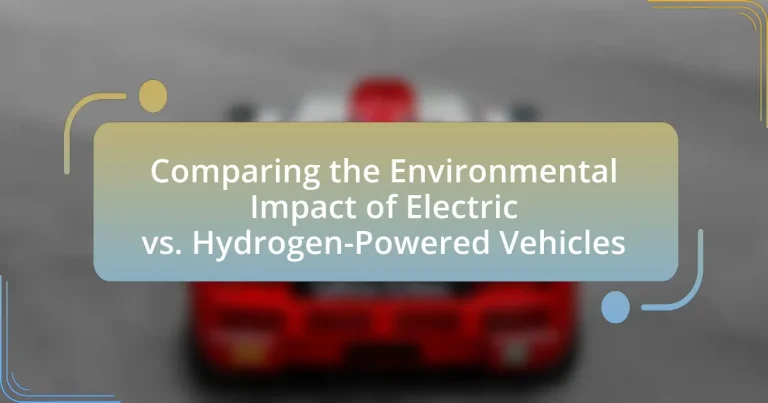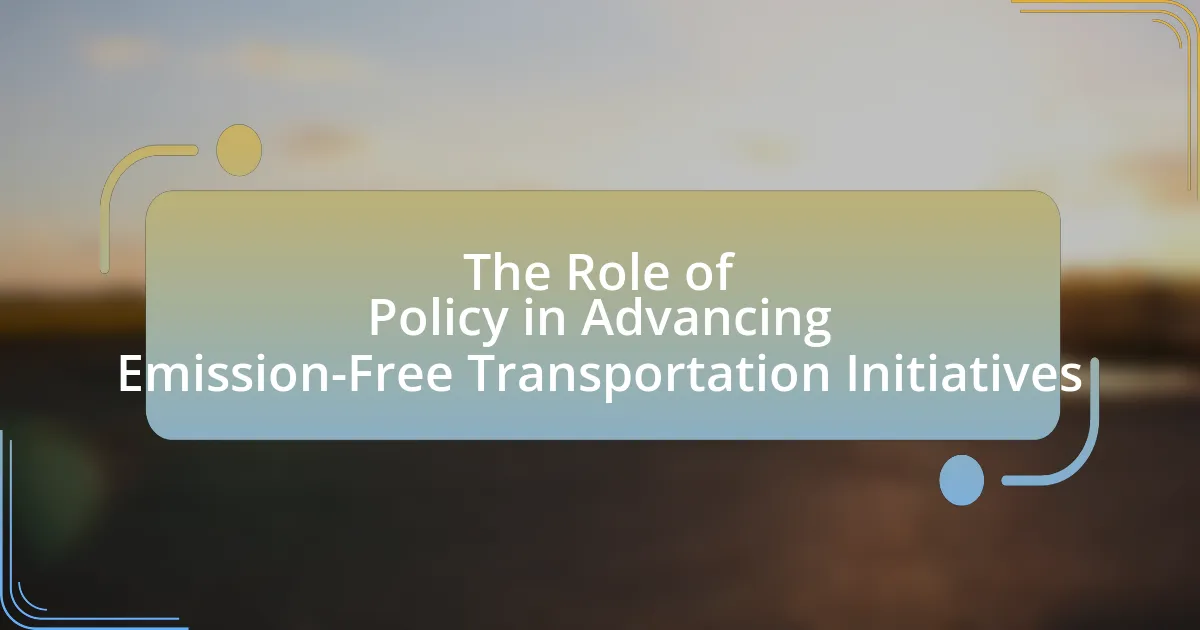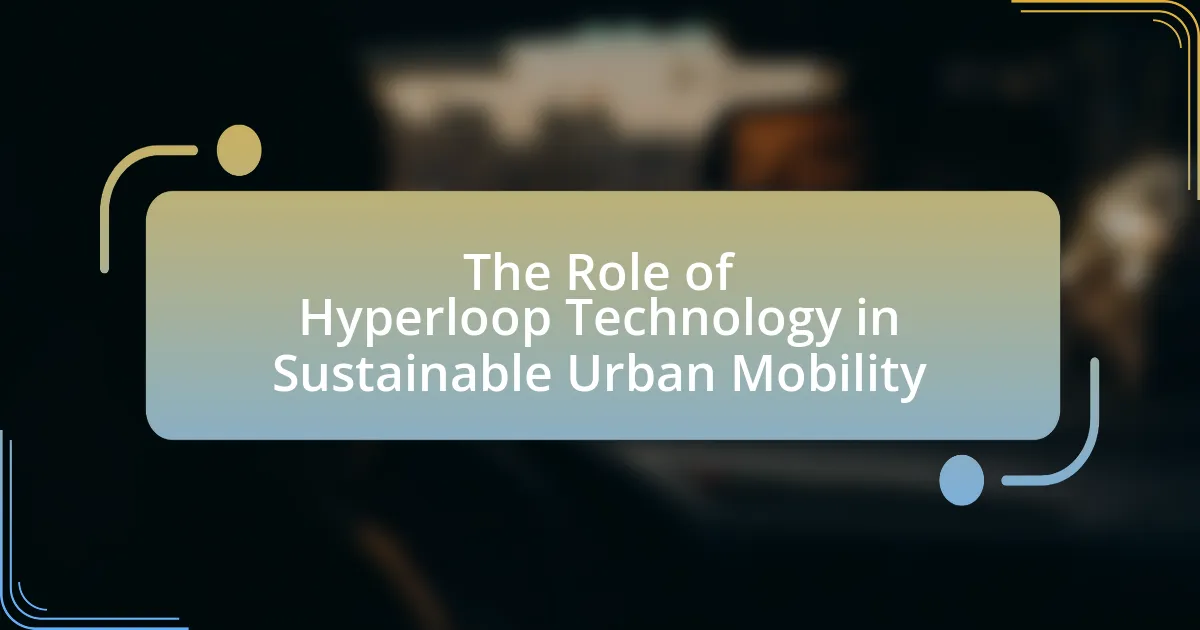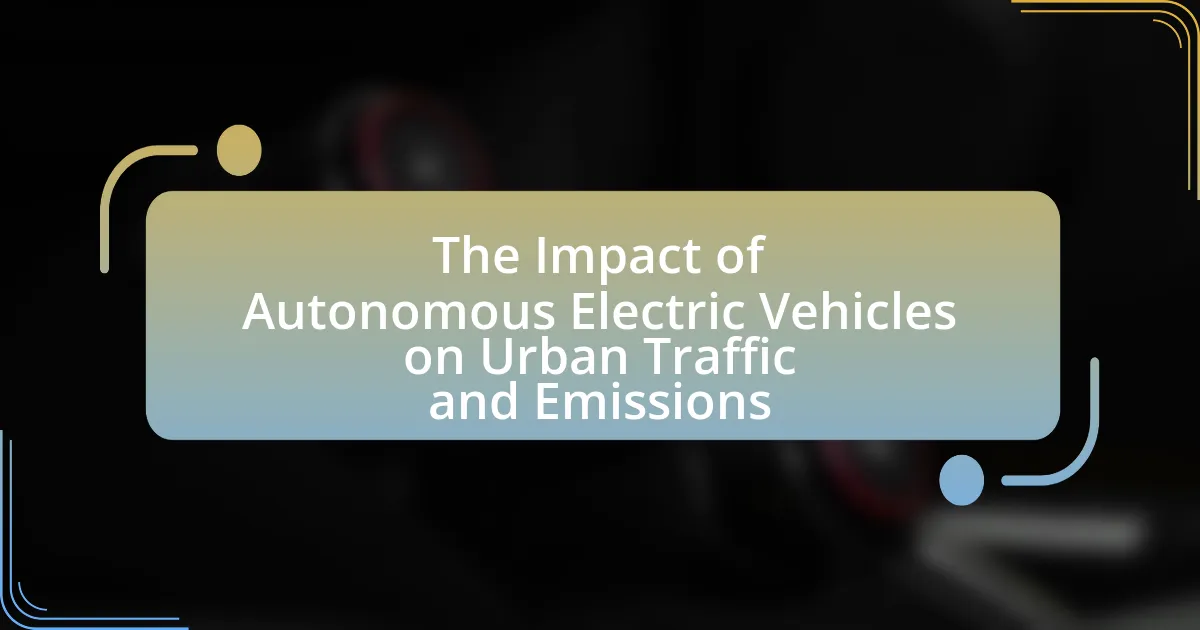The article examines the environmental impacts of electric and hydrogen-powered vehicles, highlighting their emissions, resource use, and overall sustainability. Electric vehicles (EVs) produce zero tailpipe emissions and can significantly reduce greenhouse gas emissions, especially when charged with renewable energy. In contrast, hydrogen vehicles emit only water vapor during operation, but their hydrogen production often relies on fossil fuels, which can generate carbon emissions. The article further explores the lifecycle impacts, resource extraction concerns, and future trends in technology and infrastructure that may influence the environmental footprint of both vehicle types. Key differences in energy sources, production methods, and end-of-life disposal are also discussed, providing a comprehensive comparison of the two alternatives to fossil fuel-powered vehicles.
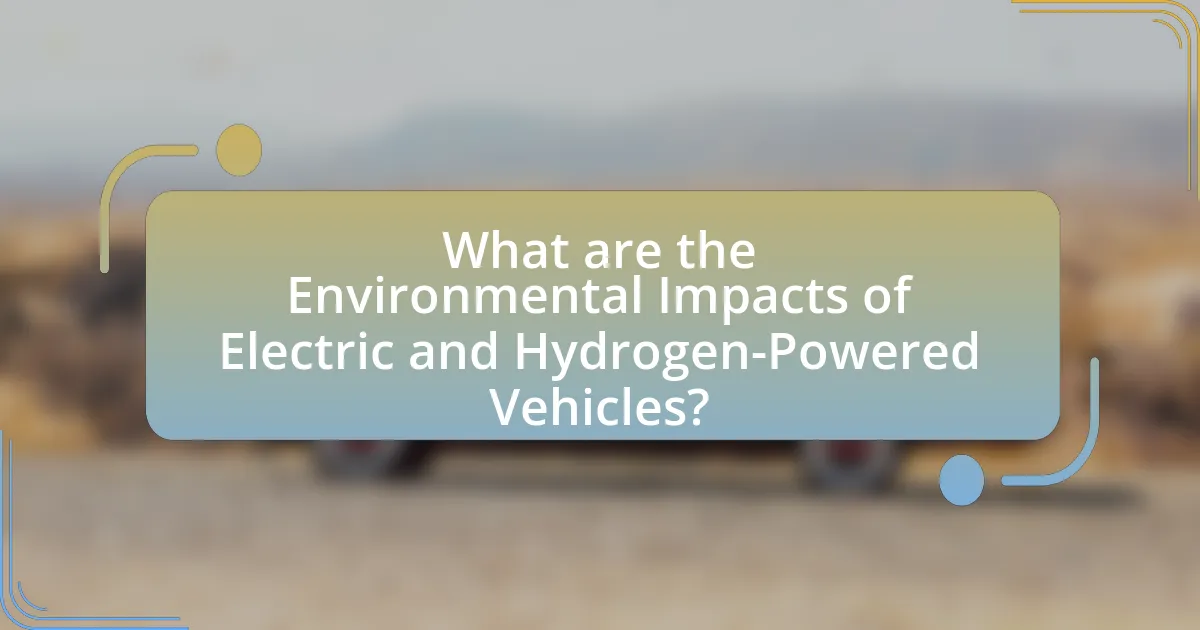
What are the Environmental Impacts of Electric and Hydrogen-Powered Vehicles?
Electric and hydrogen-powered vehicles have distinct environmental impacts primarily related to emissions and resource use. Electric vehicles (EVs) produce zero tailpipe emissions, significantly reducing air pollution in urban areas. However, their environmental footprint includes emissions from electricity generation, particularly if sourced from fossil fuels; studies indicate that EVs can still result in lower overall greenhouse gas emissions compared to traditional gasoline vehicles, especially as the energy grid becomes greener.
Hydrogen-powered vehicles emit only water vapor during operation, making them environmentally friendly at the point of use. However, the production of hydrogen often relies on natural gas through a process called steam methane reforming, which can generate significant carbon emissions. Alternatively, producing hydrogen via electrolysis using renewable energy can mitigate these impacts, but this method is currently less common and more energy-intensive.
In summary, while both electric and hydrogen vehicles offer cleaner alternatives to fossil fuel-powered cars, their environmental impacts vary based on energy sources and production methods. Transitioning to renewable energy for electricity and hydrogen production is crucial for maximizing the environmental benefits of both vehicle types.
How do electric vehicles contribute to environmental sustainability?
Electric vehicles (EVs) contribute to environmental sustainability by reducing greenhouse gas emissions and decreasing reliance on fossil fuels. EVs produce zero tailpipe emissions, which significantly lowers air pollution in urban areas. According to the U.S. Environmental Protection Agency, the transportation sector accounts for approximately 29% of total greenhouse gas emissions in the United States, and transitioning to electric vehicles can help mitigate this impact. Furthermore, when charged with renewable energy sources, such as solar or wind, the overall carbon footprint of EVs is further diminished, enhancing their sustainability profile. Studies indicate that EVs can reduce lifecycle emissions by up to 70% compared to traditional gasoline vehicles, demonstrating their effectiveness in promoting a cleaner environment.
What are the emissions associated with electric vehicle production?
The emissions associated with electric vehicle production primarily stem from the manufacturing processes, particularly the production of batteries. Battery production can generate significant greenhouse gas emissions, estimated at around 150 to 200 kg of CO2 equivalent per kilowatt-hour of battery capacity. This is largely due to the extraction and processing of raw materials such as lithium, cobalt, and nickel, which are energy-intensive processes. Additionally, the overall lifecycle emissions of electric vehicles, including production, can be higher than those of conventional vehicles when considering the energy sources used in manufacturing. Studies indicate that the total emissions from electric vehicle production can range from 50% to 100% higher than those of internal combustion engine vehicles, depending on the energy mix used in the manufacturing process.
How do electric vehicles affect air quality during operation?
Electric vehicles (EVs) significantly improve air quality during operation by producing zero tailpipe emissions. Unlike conventional gasoline or diesel vehicles, which emit pollutants such as nitrogen oxides and particulate matter, EVs operate solely on electricity, resulting in cleaner air in urban environments. Studies indicate that widespread adoption of EVs could lead to a substantial reduction in air pollution levels; for instance, a report by the Union of Concerned Scientists found that transitioning to EVs could reduce greenhouse gas emissions by up to 70% compared to traditional vehicles, depending on the energy source used for electricity generation. This reduction in harmful emissions directly contributes to better air quality and public health outcomes.
What are the environmental benefits of hydrogen-powered vehicles?
Hydrogen-powered vehicles offer significant environmental benefits, primarily through their zero-emission operation. When hydrogen fuel is used in these vehicles, the only byproduct is water vapor, which drastically reduces air pollutants compared to traditional gasoline or diesel vehicles that emit carbon dioxide and other harmful substances. According to the U.S. Department of Energy, hydrogen fuel cells can achieve efficiencies of up to 60%, which is higher than internal combustion engines, leading to lower overall greenhouse gas emissions when considering the entire fuel cycle. Additionally, hydrogen can be produced from renewable sources, such as wind or solar energy, further enhancing its sustainability and reducing reliance on fossil fuels.
How is hydrogen produced and what are its environmental implications?
Hydrogen is primarily produced through methods such as steam methane reforming, electrolysis, and gasification. Steam methane reforming, which accounts for about 95% of hydrogen production, involves reacting natural gas with steam to produce hydrogen and carbon dioxide. Electrolysis, a cleaner method, uses electricity to split water into hydrogen and oxygen, but its environmental impact depends on the source of the electricity used. Gasification converts organic materials into hydrogen and other products, but it can also release greenhouse gases.
The environmental implications of hydrogen production vary significantly by method. Steam methane reforming contributes to greenhouse gas emissions due to the carbon dioxide released during the process. In contrast, hydrogen produced via electrolysis using renewable energy sources can be nearly carbon-neutral, significantly reducing its environmental footprint. However, the overall impact also depends on the efficiency of the production process and the lifecycle emissions associated with the energy sources used.
What emissions are generated during the operation of hydrogen vehicles?
Hydrogen vehicles primarily emit water vapor during operation, as they convert hydrogen fuel into electricity through a chemical reaction in fuel cells. This process produces no harmful pollutants such as carbon dioxide or nitrogen oxides, making hydrogen vehicles a clean alternative to traditional fossil fuel-powered vehicles. According to the U.S. Department of Energy, the only byproduct of this reaction is water, which underscores the environmental benefits of hydrogen fuel cell technology.
How do the lifecycle impacts of electric and hydrogen vehicles compare?
The lifecycle impacts of electric vehicles (EVs) and hydrogen vehicles (HVs) differ primarily in their emissions, resource use, and energy efficiency. EVs typically have lower greenhouse gas emissions during operation, especially when charged from renewable energy sources, while HVs produce emissions primarily during hydrogen production, which often relies on fossil fuels.
In terms of resource use, EVs require significant amounts of lithium, cobalt, and nickel for batteries, which can lead to environmental degradation from mining activities. Conversely, HVs require platinum for fuel cells, which also has environmental and ethical implications due to mining practices.
Energy efficiency is another critical factor; EVs convert about 60-77% of electrical energy from the grid to power at the wheels, whereas HVs convert only about 20-30% of the energy from hydrogen production to power at the wheels. This efficiency gap indicates that EVs generally have a more favorable lifecycle impact compared to HVs, particularly when considering the entire energy chain from production to operation.
What are the resource extraction impacts for both vehicle types?
Electric vehicles (EVs) primarily impact resource extraction through the demand for lithium, cobalt, and nickel used in batteries, leading to significant mining activities that can result in habitat destruction and water pollution. For instance, lithium extraction in South America has been linked to water depletion in local communities, while cobalt mining in the Democratic Republic of Congo often involves child labor and severe environmental degradation.
Hydrogen-powered vehicles (HPVs) impact resource extraction mainly through the production of hydrogen, which often relies on natural gas reforming, a process that contributes to greenhouse gas emissions and requires extensive fossil fuel extraction. Additionally, the production of hydrogen fuel cells involves rare materials like platinum, which necessitates mining that can disrupt ecosystems and contribute to pollution.
In summary, both vehicle types have distinct resource extraction impacts: EVs are heavily reliant on battery materials that pose environmental and social challenges, while HPVs depend on fossil fuels and rare metals, each contributing to ecological and ethical concerns in their respective supply chains.
How do end-of-life disposal methods differ between electric and hydrogen vehicles?
End-of-life disposal methods for electric vehicles (EVs) primarily focus on battery recycling, while hydrogen vehicles (FCEVs) emphasize the recycling of fuel cells and associated components. Electric vehicles contain lithium-ion batteries, which require specialized recycling processes to recover valuable materials like lithium, cobalt, and nickel, with recycling rates reaching up to 95% for some materials. In contrast, hydrogen vehicles utilize fuel cells that can be dismantled and their components, such as platinum and membrane materials, recycled, but the recycling infrastructure for fuel cells is less developed compared to that for EV batteries. This difference in disposal methods reflects the distinct technologies and materials used in each vehicle type, impacting their overall environmental footprint at the end of life.
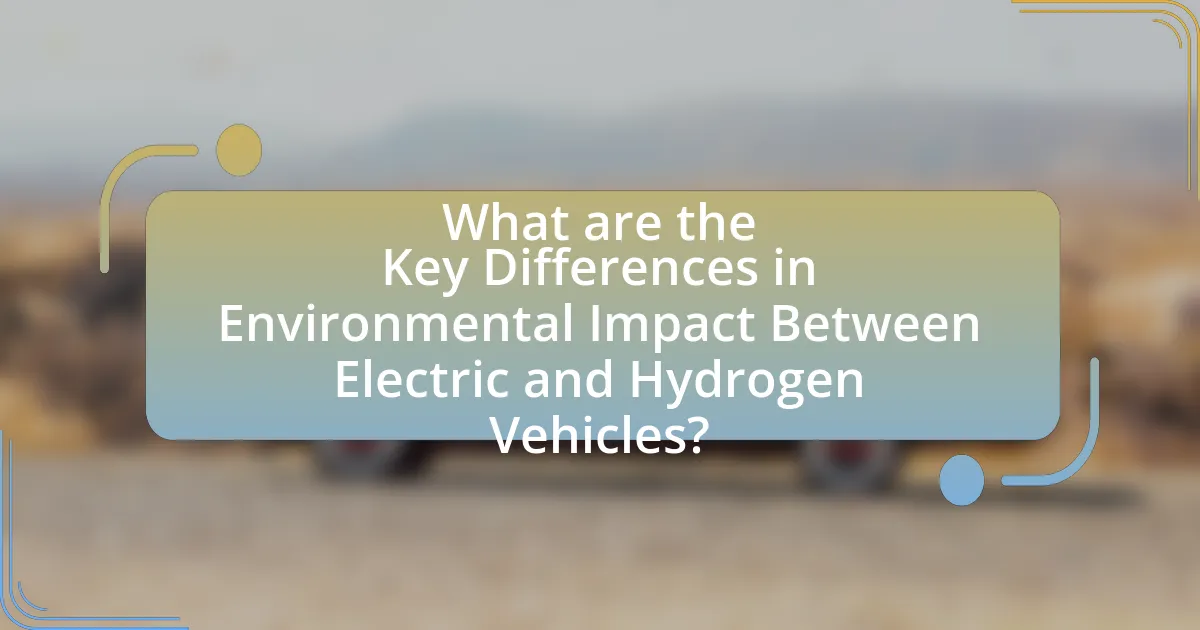
What are the Key Differences in Environmental Impact Between Electric and Hydrogen Vehicles?
Electric vehicles (EVs) generally have a lower environmental impact compared to hydrogen vehicles due to their efficiency and the current energy sources used for electricity generation. EVs convert about 60% of the electrical energy from the grid to power at the wheels, while hydrogen vehicles convert only about 20% of the energy from hydrogen production to power at the wheels.
The production of hydrogen often involves natural gas reforming, which emits significant greenhouse gases, whereas EVs can be powered by renewable energy sources, reducing their carbon footprint. According to the U.S. Department of Energy, the lifecycle emissions of EVs can be significantly lower than those of hydrogen vehicles, especially when the electricity comes from renewable sources.
Additionally, the infrastructure for hydrogen production and distribution is less developed than that for electricity, leading to higher emissions associated with hydrogen transport and storage. Overall, while both vehicle types have environmental impacts, electric vehicles currently present a more sustainable option based on efficiency and cleaner energy potential.
How do energy sources for electric and hydrogen vehicles differ?
Electric vehicles (EVs) use electricity stored in batteries as their energy source, while hydrogen vehicles utilize hydrogen gas, which is converted into electricity through a fuel cell. The primary distinction lies in the energy storage and conversion methods: EVs rely on battery technology, which can be charged from various electricity sources, including renewable energy, whereas hydrogen vehicles require hydrogen production, often through processes like electrolysis or steam methane reforming. According to the U.S. Department of Energy, hydrogen production can be carbon-intensive if derived from fossil fuels, while battery electric vehicles can achieve lower emissions when charged with renewable energy sources.
What types of energy are used to charge electric vehicles?
Electric vehicles are charged using various types of energy, primarily electricity sourced from the grid, renewable energy sources, and battery storage systems. The electricity from the grid can come from fossil fuels, nuclear power, or renewable sources such as solar, wind, and hydroelectric power. According to the U.S. Energy Information Administration, in 2021, about 60% of electricity generation in the United States came from fossil fuels, while renewable sources accounted for approximately 20%. This indicates that the environmental impact of charging electric vehicles can vary significantly based on the energy mix of the local grid. Additionally, electric vehicles can be charged using solar panels or wind turbines, which provide a cleaner energy source, further reducing their carbon footprint.
What are the primary methods of hydrogen production and their impacts?
The primary methods of hydrogen production include steam methane reforming (SMR), electrolysis, and biomass gasification. Steam methane reforming, which accounts for about 95% of hydrogen production, involves reacting natural gas with steam, resulting in significant carbon dioxide emissions, contributing to climate change. Electrolysis, the process of using electricity to split water into hydrogen and oxygen, can be environmentally friendly if powered by renewable energy sources, but it is currently more expensive and less efficient than SMR. Biomass gasification converts organic materials into hydrogen, offering a renewable option, but it can lead to land use changes and emissions if not managed sustainably. Each method has distinct environmental impacts, influencing the overall sustainability of hydrogen as an energy carrier.
What role do infrastructure and technology play in the environmental impact?
Infrastructure and technology significantly influence environmental impact by determining energy efficiency and emissions associated with vehicle operation. For instance, the availability of charging stations for electric vehicles and hydrogen refueling stations directly affects the adoption rates of these technologies, which in turn impacts overall greenhouse gas emissions. Research indicates that regions with robust electric vehicle infrastructure see a reduction in carbon emissions by up to 30% compared to areas lacking such infrastructure. Additionally, advancements in battery technology and hydrogen production methods can further minimize environmental footprints, with studies showing that green hydrogen production can reduce emissions by 70% compared to traditional fossil fuels. Thus, effective infrastructure and innovative technology are crucial in shaping the environmental outcomes of electric and hydrogen-powered vehicles.
How does the charging infrastructure for electric vehicles affect the environment?
The charging infrastructure for electric vehicles significantly affects the environment by influencing energy consumption and emissions. The establishment of charging stations often requires substantial land use and resource extraction, which can lead to habitat disruption and increased carbon footprints during construction. Furthermore, the environmental impact of charging infrastructure is closely tied to the energy sources used to generate electricity; for instance, charging stations powered by renewable energy sources like wind or solar have a lower environmental impact compared to those relying on fossil fuels. According to the U.S. Department of Energy, transitioning to renewable energy for electric vehicle charging can reduce greenhouse gas emissions by up to 70% compared to traditional gasoline vehicles. Thus, the overall environmental effect of charging infrastructure is contingent upon the energy mix and the ecological considerations of its development.
What infrastructure is needed for hydrogen vehicles and its environmental costs?
Hydrogen vehicles require a comprehensive infrastructure that includes hydrogen production facilities, storage systems, distribution networks, and refueling stations. Hydrogen production typically involves methods such as electrolysis or steam methane reforming, with the latter being more common but associated with higher carbon emissions. Storage systems must safely contain hydrogen, often using high-pressure tanks, while distribution networks transport hydrogen from production sites to refueling stations. Refueling stations are essential for providing hydrogen to vehicles, and as of 2023, there are approximately 50 operational stations in the United States.
The environmental costs associated with hydrogen vehicles primarily stem from the methods used to produce hydrogen. For instance, steam methane reforming emits significant greenhouse gases, while electrolysis, if powered by renewable energy, can minimize emissions. A study by the National Renewable Energy Laboratory indicates that hydrogen production from renewable sources can reduce lifecycle greenhouse gas emissions by up to 70% compared to fossil fuel-based methods. Therefore, the environmental impact of hydrogen vehicles is closely linked to the sustainability of the hydrogen production process.
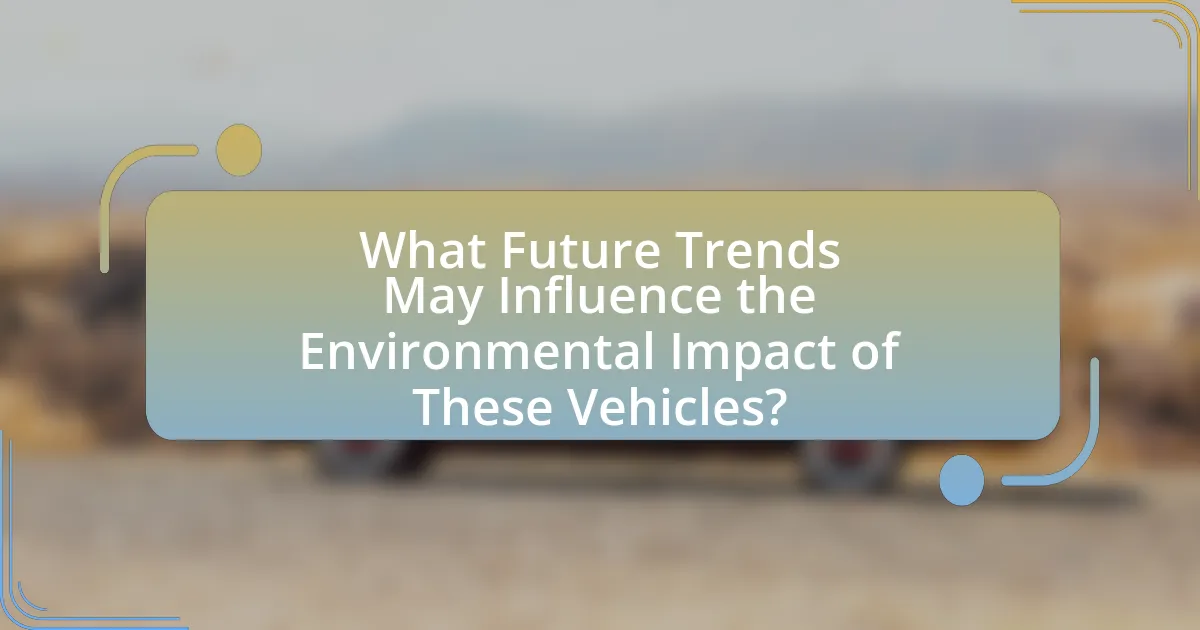
What Future Trends May Influence the Environmental Impact of These Vehicles?
Future trends that may influence the environmental impact of electric and hydrogen-powered vehicles include advancements in battery technology, renewable energy integration, and hydrogen production methods. Improved battery technology, such as solid-state batteries, can enhance energy density and reduce resource extraction impacts, while the shift towards renewable energy sources for electricity generation can lower the carbon footprint of electric vehicles. Additionally, the development of green hydrogen production methods, such as electrolysis powered by renewable energy, can significantly reduce the environmental impact of hydrogen vehicles. These trends are supported by research indicating that transitioning to cleaner energy sources and innovative technologies can lead to substantial reductions in greenhouse gas emissions associated with both vehicle types.
How might advancements in battery technology affect electric vehicle sustainability?
Advancements in battery technology significantly enhance electric vehicle sustainability by increasing energy density, reducing charging times, and extending battery life. Higher energy density allows electric vehicles to travel longer distances on a single charge, which can reduce the frequency of charging and associated energy consumption. For instance, the development of solid-state batteries has the potential to increase energy density by up to 50% compared to traditional lithium-ion batteries. Additionally, faster charging technologies, such as ultra-fast charging systems, can minimize downtime for electric vehicles, making them more convenient for users. Furthermore, improvements in battery lifespan reduce the need for frequent replacements, which lowers the environmental impact associated with battery production and disposal. According to a study by the International Council on Clean Transportation, advancements in battery technology could lead to a 30% reduction in lifecycle greenhouse gas emissions for electric vehicles by 2030.
What are the potential environmental benefits of solid-state batteries?
Solid-state batteries offer significant environmental benefits, primarily through reduced reliance on harmful materials and enhanced energy efficiency. Unlike traditional lithium-ion batteries, solid-state batteries utilize solid electrolytes, which can eliminate the need for toxic liquid electrolytes and reduce the risk of leakage and fires. This shift can lead to lower environmental contamination during production and disposal. Additionally, solid-state batteries have a higher energy density, which allows for longer-lasting energy storage and potentially fewer batteries needed over time, thereby decreasing resource extraction and waste generation. Studies indicate that solid-state batteries can also improve the overall lifecycle emissions of electric vehicles, contributing to a lower carbon footprint compared to conventional battery technologies.
How could recycling technologies improve the lifecycle impact of electric vehicles?
Recycling technologies can significantly improve the lifecycle impact of electric vehicles by enabling the recovery and reuse of valuable materials, such as lithium, cobalt, and nickel, from spent batteries. This process reduces the need for new raw material extraction, which is often environmentally damaging and energy-intensive. For instance, a study by the International Energy Agency indicates that recycling can recover up to 95% of lithium from used batteries, thereby minimizing the carbon footprint associated with mining and processing new materials. Additionally, enhanced recycling methods can lead to lower production costs and reduced waste, further contributing to the sustainability of electric vehicles throughout their lifecycle.
What innovations in hydrogen production could reduce its environmental footprint?
Innovations in hydrogen production that could reduce its environmental footprint include the development of green hydrogen technologies, such as electrolysis powered by renewable energy sources like wind and solar. This method significantly lowers carbon emissions compared to traditional hydrogen production methods, which often rely on fossil fuels. For instance, a study by the International Renewable Energy Agency (IRENA) indicates that green hydrogen can reduce greenhouse gas emissions by up to 90% compared to hydrogen produced from natural gas. Additionally, advancements in photoelectrochemical water splitting and biomass gasification are emerging as promising methods to produce hydrogen sustainably, further minimizing environmental impacts.
How might renewable energy integration change hydrogen production methods?
Renewable energy integration can significantly change hydrogen production methods by enabling the use of electrolysis powered by renewable sources like wind and solar. This shift allows for the production of green hydrogen, which is generated without carbon emissions, contrasting with traditional methods such as steam methane reforming that rely on fossil fuels. According to the International Renewable Energy Agency, the cost of producing green hydrogen through renewable-powered electrolysis is expected to decrease by 30% by 2030, making it a more viable and sustainable option. This transition not only enhances the environmental benefits of hydrogen production but also aligns with global efforts to reduce greenhouse gas emissions and combat climate change.
What are the prospects for green hydrogen in reducing emissions?
Green hydrogen has significant prospects for reducing emissions, primarily because it is produced using renewable energy sources, which results in zero carbon emissions during its generation. The International Energy Agency (IEA) projects that green hydrogen could account for up to 24% of global energy demand by 2050, potentially reducing annual CO2 emissions by 6 gigatons. This reduction is achievable as green hydrogen can replace fossil fuels in various sectors, including transportation, industry, and heating, thereby facilitating a transition to a low-carbon economy.
What practical considerations should consumers keep in mind regarding environmental impact?
Consumers should consider the lifecycle emissions of both electric and hydrogen-powered vehicles when evaluating their environmental impact. Electric vehicles (EVs) typically produce lower emissions during operation, but the environmental cost of battery production and electricity generation must be factored in. For instance, a study by the Union of Concerned Scientists indicates that EVs can reduce greenhouse gas emissions by 50% compared to gasoline vehicles, depending on the energy source used for electricity.
On the other hand, hydrogen vehicles emit only water vapor during operation, but the production of hydrogen often involves fossil fuels, which can negate some of the environmental benefits. According to the U.S. Department of Energy, hydrogen production from natural gas can result in significant CO2 emissions, while renewable methods like electrolysis are still developing and not widely implemented.
Additionally, consumers should evaluate the availability of charging infrastructure for EVs and hydrogen refueling stations, as this can influence the practicality of owning either type of vehicle. The environmental impact also varies based on regional energy sources, making local context crucial in decision-making.
How can consumers make informed choices between electric and hydrogen vehicles?
Consumers can make informed choices between electric and hydrogen vehicles by evaluating factors such as environmental impact, infrastructure availability, and total cost of ownership. Electric vehicles (EVs) produce zero tailpipe emissions and are generally more efficient, with studies indicating that they convert about 77% of electrical energy from the grid to power at the wheels. In contrast, hydrogen vehicles emit only water vapor but involve energy losses during hydrogen production, storage, and transportation, with only about 20% of the energy from hydrogen reaching the wheels.
Additionally, consumers should consider the availability of charging stations for EVs versus hydrogen refueling stations, which are significantly fewer in number. As of 2023, there are over 100,000 public charging stations in the U.S. compared to approximately 50 hydrogen stations. Lastly, the total cost of ownership, including purchase price, maintenance, and fuel costs, varies; EVs typically have lower operating costs due to fewer moving parts and lower fuel costs. By analyzing these aspects, consumers can make more informed decisions aligned with their preferences and circumstances.
What are the best practices for minimizing the environmental impact of vehicle use?
The best practices for minimizing the environmental impact of vehicle use include adopting fuel-efficient driving habits, utilizing public transportation, and transitioning to electric or hydrogen-powered vehicles. Fuel-efficient driving habits, such as maintaining steady speeds and reducing idling, can improve fuel economy by 15-30%, thereby lowering greenhouse gas emissions. Public transportation reduces the number of individual vehicles on the road, which can significantly decrease overall emissions; for instance, a study by the American Public Transportation Association found that public transit saves 45 million metric tons of CO2 annually. Transitioning to electric or hydrogen-powered vehicles is crucial, as they produce zero tailpipe emissions and can be powered by renewable energy sources, further reducing their environmental footprint.
